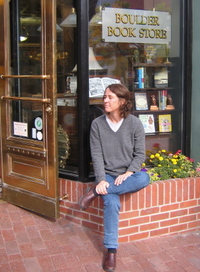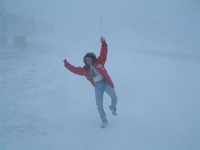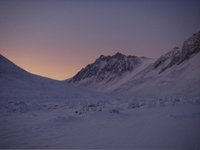Bill Jirsa: "Antarctica Trumped my Funk"
 It's hard to describe Ice People--but if I had one word it would be eclectic. I was fascinated, intrigued and often in awe of those I met, so in these pages I will introduce you to some, and have them describe their experiences this season. So: meet Bill Jirsa, computer wizard, master of languages, and a beautiful writer. I recently asked him what he was up to on the ice and this is his amazing response. You can find more of his writing at icetongue (the world’s southernmost literary journal) or on his website elementarypenguin.
It's hard to describe Ice People--but if I had one word it would be eclectic. I was fascinated, intrigued and often in awe of those I met, so in these pages I will introduce you to some, and have them describe their experiences this season. So: meet Bill Jirsa, computer wizard, master of languages, and a beautiful writer. I recently asked him what he was up to on the ice and this is his amazing response. You can find more of his writing at icetongue (the world’s southernmost literary journal) or on his website elementarypenguin.
Bill writes: I was stranded at Lake Hoare last week. The weather changed while I was there to install the computer systems. I had about one day of work, and I ended up there for six nights as the weather remained just dodgy enough to cancel helo flights. I had to stay close to the radio through the day in case the weather opened up, but each day by about 3 or 4 pm they would cancel the day outright and tell the pilots to get some sleep. That’s when I set out for a night of wandering the Taylor Valley. This is my fourth season working in Antarctica. My job seldom takes me far from the station, and I’ve resisted returning to work here this year—thinking I should grow up and get a job where I don’t live in a dorm, start cooking for myself again. Mostly I’ve started to feel a bit sad that Antarctica has begun to feel ordinary to me.
It's hard to describe Ice People--but if I had one word it would be eclectic. I was fascinated, intrigued and often in awe of those I met, so in these pages I will introduce you to some, and have them describe their experiences this season. So: meet Bill Jirsa, computer wizard, master of languages, and a beautiful writer. I recently asked him what he was up to on the ice and this is his amazing response. You can find more of his writing at icetongue (the world’s southernmost literary journal) or on his website elementarypenguin.
Bill writes: I was stranded at Lake Hoare last week. The weather changed while I was there to install the computer systems. I had about one day of work, and I ended up there for six nights as the weather remained just dodgy enough to cancel helo flights. I had to stay close to the radio through the day in case the weather opened up, but each day by about 3 or 4 pm they would cancel the day outright and tell the pilots to get some sleep. That’s when I set out for a night of wandering the Taylor Valley. This is my fourth season working in Antarctica. My job seldom takes me far from the station, and I’ve resisted returning to work here this year—thinking I should grow up and get a job where I don’t live in a dorm, start cooking for myself again. Mostly I’ve started to feel a bit sad that Antarctica has begun to feel ordinary to me.
There’s about a half hour from 10:30 to 11:00p each night this time
of year when the sun wheels around to the south and aligns with the
slot between the peaks over the Taylor Glacier and if it happens to
clear up, the evening light spills in like butterscotch (as Joni
Mitchell would say), and the face of the glaciers light up like
multifaceted glass. I was partway up a ridge in a particular location
that should remain undisclosed. I felt the cold starting to seep in as
soon as I stopped to watch the light, frost on my eyelashes, flapping
my arms to keep warm—but comfortably within my personal system for
staying warm in this climate. The ridge across the valley lit up as the
golden light began to crawl across the valley floor. I poured myself a
cup of green tea from my thermos (I take it a little too strong and a
little too sweet to keep me going on long hikes).
The sound of me sipping was remarkable—I noted suddenly how deafeningly
quiet and calm it had become, and I realized that the only sound I’d
heard for the last seven hours was my own breathing, my own feet
crunching on the fresh snow. I had become mesmerized by the cavalcade
of my own thoughts as I’d hiked, and I realized that for the first time
in four seasons on this continent, I was utterly alone in Antarctica.
There were only two other people at all in this entire valley and they
were miles away and I knew they’d be fast asleep by now. (My radio was
off inside my pocket.) The light rolled around and climbed the ridge
where I stood, and the effect of the radiation was immediate—I shed my
parka and watched the sweat steaming off my fleece, felt the back of my
hands warming when I held them to the light, and I had to admit that
this place had trumped my funk: alright, I conceded aloud, this was an
extraordinary moment.
In a few more moments, the sun slipped behind the peaks, and the valley
returned to hard blue shadow, biting cold air in my nostrils. I packed
up and started walking again— The weather had cleared. I had a
scheduled helo pickup in about 9 hours and that was at least six or
seven hours on foot from where I stood. If I hustled, I might get a
quick nap before I had to get back to McMurdo.
Antarctica: Life on the Road
 Antarctica: Life on the Ice hit the road this past weekend. First stop: Boulder, Colorado where I read with Traci Macnamara and Beth Bartel.
Traci brought a blow-up globe so that everyone would know where the
Antarctic is (not "up there with the polar bears"). She read from her
essay about spending Thanksgiving on the ice, while Beth read from her
essay that describes her time spent on Mt. Erebus. They were both
stars. In the audience were a lot of ice people, including Elaine Hood,
from Raytheon who was my guardian angel during my trip. And then there were friends and fellow writers BK Loren and Sallie Greenwood. Christine Weeber, who contributed to Solo: On Her Own Adventure showed up, as did Jenny Dellaport, from my hometown of State College, PA! Watch for news of more readings at my website: www.susanfoxrogers.com
Antarctica: Life on the Ice hit the road this past weekend. First stop: Boulder, Colorado where I read with Traci Macnamara and Beth Bartel.
Traci brought a blow-up globe so that everyone would know where the
Antarctic is (not "up there with the polar bears"). She read from her
essay about spending Thanksgiving on the ice, while Beth read from her
essay that describes her time spent on Mt. Erebus. They were both
stars. In the audience were a lot of ice people, including Elaine Hood,
from Raytheon who was my guardian angel during my trip. And then there were friends and fellow writers BK Loren and Sallie Greenwood. Christine Weeber, who contributed to Solo: On Her Own Adventure showed up, as did Jenny Dellaport, from my hometown of State College, PA! Watch for news of more readings at my website: www.susanfoxrogers.com
Antarctica: Life on the Ice hit the road this past weekend. First stop: Boulder, Colorado where I read with Traci Macnamara and Beth Bartel.
Traci brought a blow-up globe so that everyone would know where the
Antarctic is (not "up there with the polar bears"). She read from her
essay about spending Thanksgiving on the ice, while Beth read from her
essay that describes her time spent on Mt. Erebus. They were both
stars. In the audience were a lot of ice people, including Elaine Hood,
from Raytheon who was my guardian angel during my trip. And then there were friends and fellow writers BK Loren and Sallie Greenwood. Christine Weeber, who contributed to Solo: On Her Own Adventure showed up, as did Jenny Dellaport, from my hometown of State College, PA! Watch for news of more readings at my website: www.susanfoxrogers.com
Karen Joyce: Frozen Hard and Thawed Out
 A storm has been walloping Antarctica for the past few days. Karen Joyce, intrepid to the end, has ventured out to take this photograph. I wish I’d been there…
A storm has been walloping Antarctica for the past few days. Karen Joyce, intrepid to the end, has ventured out to take this photograph. I wish I’d been there…
The contributors to Antarctica: Life on the Ice lead fascinating lives. From time to time I’ll track them down and find out what they are doing.
Karen, who contributed a hilarious essay, “The Day It Rained Chickens,” to Antarctica: Life on the Ice is currently in McMurdo, as she has been for the past 17 years during the austral summer. She will be joining us live from the Antarctic for our virtual book tour on November 29.
A storm has been walloping Antarctica for the past few days. Karen Joyce, intrepid to the end, has ventured out to take this photograph. I wish I’d been there…
The contributors to Antarctica: Life on the Ice lead fascinating lives. From time to time I’ll track them down and find out what they are doing.
Karen, who contributed a hilarious essay, “The Day It Rained Chickens,” to Antarctica: Life on the Iceis currently in McMurdo, as she has been for the past 17 years during the austral summer. She will be joining us live from the Antarctic for our virtual book tour on November 29.
“It's strange how much I love this place, even though I
am absolutely the wrong body type for Antarctica. Cold places select
for gigantism, for a ratio of surface area to interior space that
maximizes the latter, and I am a wee peanut of a woman. I have been
frozen hard and thawed out so many times, I ought to be a quaking
gelatinous mess by now.”
Karen should be working on her second novel, The Winter of My Discount
Tent but instead, this is what she reports from the ice:
“I dream
about missing airplanes, traveling in unrecognizable countries, always
enroute somewhere and there is always trouble. I suffer this job for 10 hours a day and in the evening I paint, teach
exercise classes, write and drink single-malt Scotch. For the first
time in my life, I count the days till I can leave, but I don't know
where I want to go. That's it in a nutshell.”
Antarctic Art
 Herbert Ponting
is an extraordinary photographer who accompanied Captain Robert F. Scott on Scott's 1910
expedition to the South Pole. His photographs of the Ice are classics. In the hut at
Cape Evans, Antarctica, which I visited, is a small darkroom where he processed his photos.
Contemporary photographers have an easier time, technologically, but
their photos are no less stunning. The University of Wyoming and the National Science Foundation have assembled the work of seven artists, including Ponting.
Herbert Ponting
is an extraordinary photographer who accompanied Captain Robert F. Scott on Scott's 1910
expedition to the South Pole. His photographs of the Ice are classics. In the hut at
Cape Evans, Antarctica, which I visited, is a small darkroom where he processed his photos.
Contemporary photographers have an easier time, technologically, but
their photos are no less stunning. The University of Wyoming and the National Science Foundation have assembled the work of seven artists, including Ponting.
Herbert Ponting is an extraordinary photographer who accompanied Captain Robert F. Scott on Scott's 1910 expedition to the South Pole. His photographs of the Ice are classics. In the hut at Cape Evans, Antarctica, which I visited, is a small darkroom where he processed his photos.
Contemporary photographers have an easier time, technologically, but their photos are no less stunning. The University of Wyoming and the National Science Foundation have assembled the work of seven artists, including Ponting.
The exhibit celebrates the 50th anniversary of the Antarctic Artists and Writers Program and is part of the global activities recognizing the 100th anniversary of the discovery and exploration of the Polar Regions. The first photographer to visit Antarctica under the NSF Antarctic Artists and Writers Program, Eliot Furness Porter (American, 1901-1990) is represented by works from the Art Museum's permanent collection. Four contemporary photographers and one sound artist, all of whom have worked in Antarctica over the last 20 years under the same NSF program and who complete the exhibition are Stuart Klipper, Neelon Crawford, Jody Forster, Joan Myers, and Douglas Quin. Check out the images on the University of Wyoming website.



